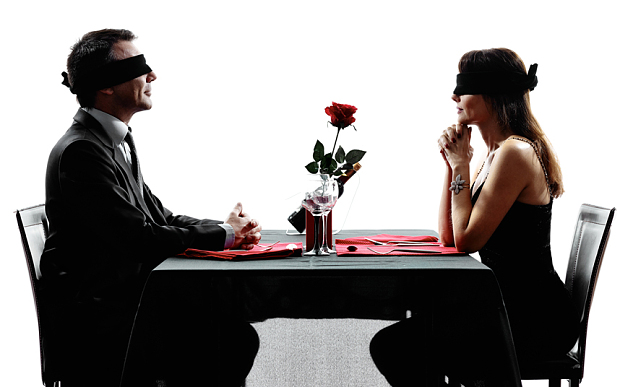Turning the lights out or wearing a blindfold while eating could be a quick way to lose weight, according to scientists.
科学家称,关上灯或是蒙上眼睛吃东西,不失为一条减肥的捷径。
The simple trick works because it stops diners eating for pleasure rather than for calories. It also triggers a part of the brain that is worried that unseen food may be rotten without visual clues to show it is fresh.
这一方法之所以有效,是因为它降低了美食的诱惑力,同时让大脑无从判断食物新鲜与否,进而影响食欲。
An experiment by the University of Konstanz, in Germany, found that people who were blindfolded consumed nine per cent fewer calories before they felt full, compared to those who could see.
德国康斯坦茨大学的一项试验发现,对比能够看着食物进餐的人,蒙住眼睛进食的受试者要少摄入9%卡路里。
They also vastly overestimated how much they had eaten because they could not see how much was left on the plate. Blindfolded volunteers estimated they had eaten 88 per cent more than they actually had.
同时,因为不知道盘中究竟还剩多少,蒙眼进食的人对自己刚才进食量的估计远高于实际情况。他们估计自己所吃掉的份量要比他们实际食用的高出88%。

Scientists believe that not seeing food on the table also allows the body to know when it is full in real-time rather than remembering past experiences where it might have taken a full plate to feel satiated.
科学家们还认为,摸黑进食能让人更直观地了解究竟吃多少才算饱,而平时人们根据经验,要吃上一整碗饭才满足。
It also prevents the 'cephalic' phase of digestion which is triggered by the sight of food, promoting salivation and the release of gastric juices and so makes food, literally, less easy to swallow.
人们在摸黑进食时,由于看不见食物,大脑消化组织刺激分泌的唾液与胃液就会少得多,让食物较难下咽。
Lead author Dr Britta Renner said: "Visual deprivation caused a pronounced dissociation between actual and perceived intake.
此次研究的首席作者布瑞塔·伦纳博士说:“视觉的剥夺会让自我感觉的进食量与实际情况之间产生偏差。”
"This may provide an unobtrusive and naturalistic means to change the experience of eating behaviour."
“这会在不经意间改变人们的进食体验。”
To test the effect, 50 people were blindfolded with modified ski goggles, and 40 were allowed to see their food. All were told not to eat within two hours of the experiment. They were then given three 95g bowls of cherry, caramel and vanilla ice cream and invited to eat for 15 minutes. Their bowls were taken away and the remaining ice-cream measured, while the participants were quizzed on how much they thought they had eaten.
为了验证这一影响,科学家要求50人用改造过的滑雪镜蒙住眼睛,另外40人可以看着食物进餐,并规定他们在试验用餐前的两小时内不能吃东西。接着科学家为每人提供了三碗冰淇淋,分别是樱桃、焦糖和香草口味的,每碗95克。规定用餐时间为十五分钟。之后科学家将他们的碗撤走,记录了每人吃剩的冰淇淋量,同时询问他们认为自己吃了多少。
On average the group who could see ate 116g while the blindfolded groups ate 105g. However the blindfolded group believed they had eaten 197g while compared with 159g for the non-blind volunteers.
可以看见食物的这一组每人平均吃掉了116克,而蒙住眼睛的这一组吃了105克。但在询问中,蒙眼的组认为他们吃掉了197克,而可见食物的这一组认为他们只吃了159克。
They were also asked how pleasant the ice-cream tasted and the blindfolded group rated the desert lower than those who could see.
科学家也询问了受试者们对冰淇淋味道的评价,蒙眼试验者的味觉感受不如可见食物的这一组。
"The experienced pleasure of eating was significantly lower in the blindfolded group. Not seeing the food might have decreased its incentive value. Visual cues play an important role in the eating experience and in the overall dining experience."
“蒙眼组对用餐的快乐体验明显有所降低,因为看不见食物意味着食物外在对他们的诱惑力下降。由此可以看出,视觉传递给人的信息在用餐中扮演着重要角色。”
Previous studies have shown that the visual impact of food plays a large part in the taste. While restaurants that allow diners to eat in the dark claim it triggers other senses, in fact eating in darkness is likely to taste far more bland than usual.
早前就已有研究证明,食物的视觉呈现在很大程度上也影响了它的口感。有些餐厅让食客们在黑暗的环境下用餐,认为这样的话,食客们能在味觉享受之外有其他感官体验。殊不知这样做却冲淡了食物本该有的口感。











